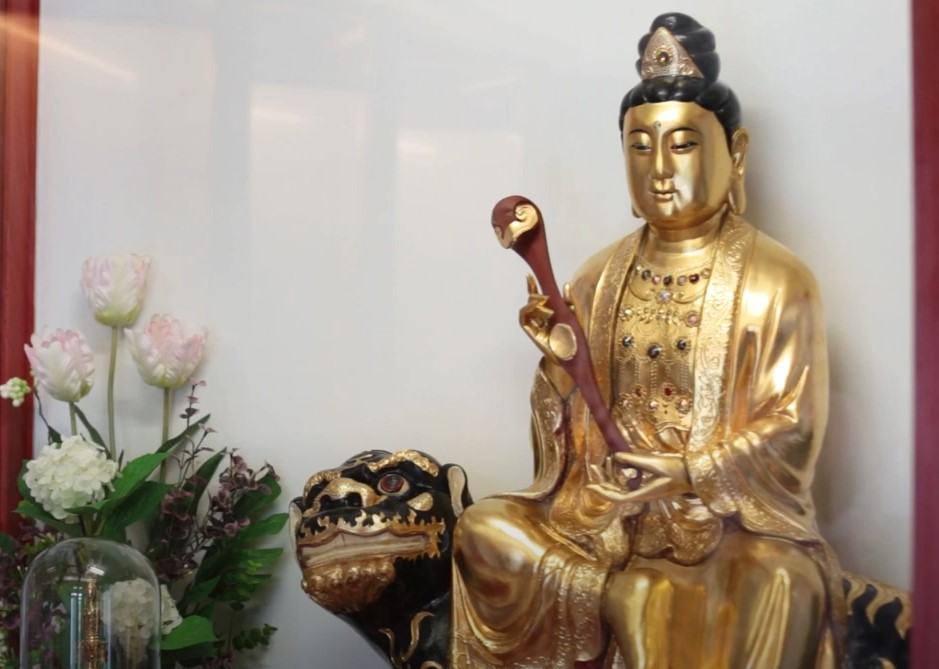Special Topics
Three Saints of the Ghanavyūha
An introduction to combinations of Buddhist statues – one buddha flanked by two bodhisattvasThree Saints of the Ghanavyūha
In Buddhist cosmology, the universe is comprised of innumerable worlds. On the Fragrant Ocean Of Boundless Light Of Wondrous Flowers (無邊妙華光香水海), there is a great lotus flower, which contains the "Base For The World Of Precious Brilliant Light Of The Ten Directions" (十方熾燃寶光明世界種). In this base, there are twenty tiers of Ghanavyūha, with each tier containing countless worlds. The Sahā World we reside in is a small world within the thirteenth tier of Ghanavyūha. As indicated in the Buddhāvataṃsaka Sūtra, the dharma-body (dharmakāya) of Sakyamuni Buddha, who taught and guided sentient beings in the Sahā World, is Vairocana (meaning "omnipresent light”) Buddha. Vairocana Buddha and buddhas of other tiers of Ghanavyūha all derive from the same pure dharma body. Ghanavyūha is the Buddha land accomplished by Vairocana Buddha because he had learned from innumerable buddhas, made innumerable great vows, and put his vows in to practice.
As explained in the Buddhāvataṃsaka Sūtra, the ultimate truth that Vairocana Buddha has attained is beyond all speech and action (sarva-vāda-caryoccheda), so the Buddha did not utter a single word throughout the process. Instead of explaining the Dharma in words, Vairocana Buddha emitted light while the two flanking bodhisattvas, Manjushri Bodhisattva and Samantabhadra Bodhisattva, shouldered the task of delivering the Dharma. According to the Lotus Sutra, these two bodhisattvas also take the responsibility for assisting Sakyamuni Buddha in propagating Buddhist scriptures. Therefore, according to different schools and different scriptures, the "Three Saints of the Ghanavyūha" can sometimes consist of Vairocana Buddha, Manjushri Bodhisattva, and Samantabhadra Bodhisattva, while sometimes Sakyamuni Buddha is at the center, with the two bodhisattvas standing by each side.
Vairocana Buddha
Different Buddhist traditions have their own interpretations regarding Vairocana Buddha. The Tiantai school (天台宗) holds that, among the trikaya of Buddha, Vairocana Buddha is the pure dharma body (dharmakāya) of the Buddha; Rocana Buddha is the enjoyment body (saṃbhogakāya) of the Buddha; while Sakyamuni Buddha is one of the myriad transformation-body (nirmānakāya) buddhas. The Huayan school (華嚴宗) regards Vairocana Buddha as the enjoyment body of the Buddha, as well as the teacher of Ghanavyūha. Regardless of the interpretation, , Vairocana Buddha is revered as representing the state of practice marked by complete perfection and non-duality. Statues of Vairocana Buddha sometimes appear in the form of a buddha sitting in the cross-legged posture, while at other times as a bodhisattva wearing a crown and jewelry, with a mudra such as a dhyāna mudrā (meditation gesture), or the Bodhyangi mudrā (the fist of wisdom).
Manjushri Bodhisattva

Manjushri Bodhisattva is known for his exceptional wisdom. As Sakyamuni Buddha once indicated in the Sutra on Placing the Alms Bowl (放缽經), Manjushri Bodhisattva had long attained the Five Wisdoms of a Tathāgata. Countless buddhas were once his disciples, including the Buddha himself. Manjushri Bodhisattva is often revered as the teacher of various buddhas. He is often depicted as a child with five buns of hair. The sword and the scripture in his hands symbolize the wisdom to cut off the afflictions of ignorance. His steed is an azure lion. Just as lions are the king of the beasts, so in Buddhism, the way buddhas and bodhisattvas speak the Dharma is often likened to the lion's roar, which can convince all sentient beings.
Samantabhadra Bodhisattva
After the Chinese translation of the Buddhāvataṃsaka Sūtra came into existence in the 5th century CE, statues of Samantabhadra Bodhisattva started to appear in China, initially, mostly, as one of the Three Saints of the Ghanavyūha. Then, in the Sui and Tang dynasties, more and more statues of Samantabhadra Bodhisattva and relevant works derived from Buddhist scriptures were created. According to the Chapter on Samantabhadrotsāhana in the Lotus Sutra, Samantabhadra Bodhisattva vowed to protect and safeguard those who recite the Lotus Sutra. Therefore, when people recite the Sutra, the Bodhisattva would arrive on a white elephant with six tusks to help them fulfill their wishes. Samantabhadra Bodhisattva mounts on a white elephant with six tusks and holds a lotus flower or Dharma instruments such as ruyi (如意, a curved decorative object). The six tusks of the elephant symbolize the practice of the Six Perfections (pāramitās), while its white color implies the quality of being undefiled. The powerful force of the elephant and its steady and firm steps represent the essence of the realm of all phenomena (dharmadhātu).
Related articles:
Buddhas and Bodhisattvas in the Pure Lands
The Triad of Sakyamuni Buddha
Three Saints of the Ghanavyūha
Three Saints of the Western Pure Land
Three Saints of the Eastern Pure Land
Buddhas of the Three Times
One Buddha Flanked by Two Disciples
Resource: Issue 402 of Humanity Magazine, Dharma Drum Publishing Corporation
Translation: Sinag-ling Li (李祥苓)
Editing: Keith Brown, Chia-Cheng Chang (張家誠)
